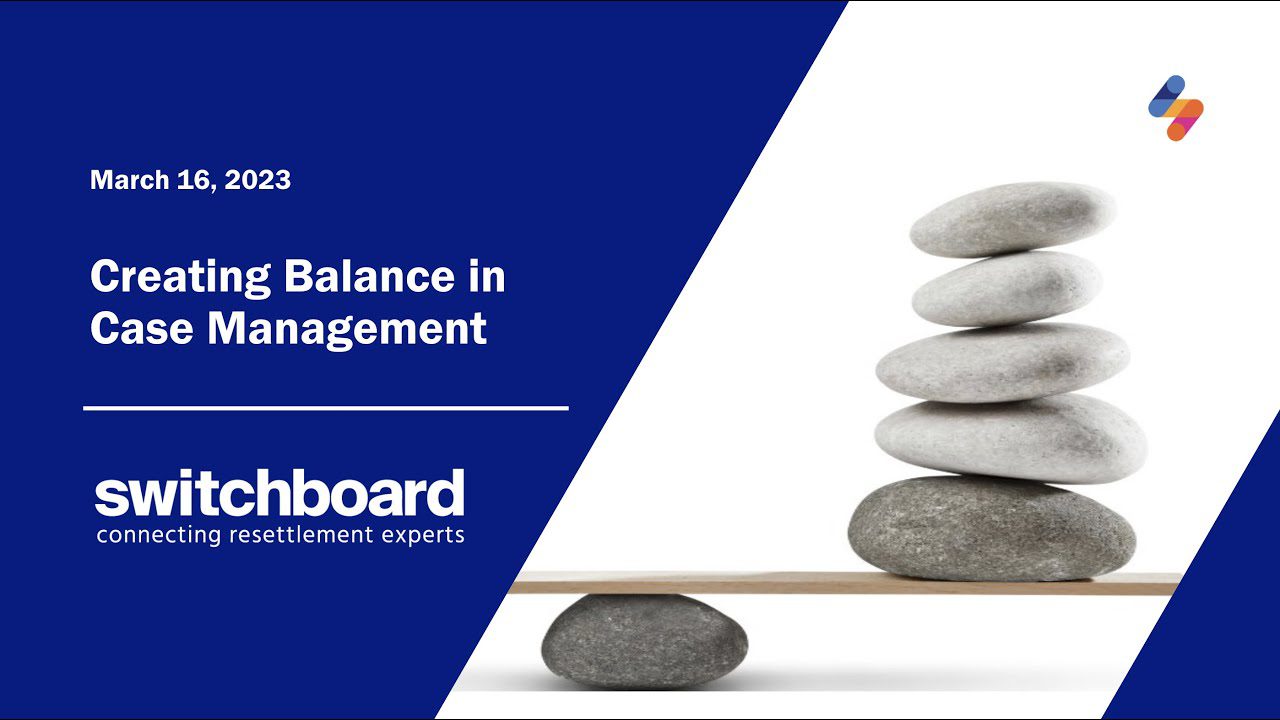Hosted in June and July, 2024 these trainings were delivered by Freschta Naseri, a contributor to the Switchboard Emerging Tech Program and a former coordinator for the team; Julie Heller, a Switchboard Emerging Tech Program Manager; and Megan Rafferty, a Switchboard Training Officer for Mental Health and Wellness.
This six-session series is designed to help service providers address Afghan newcomers’ mental health concerns by ensuring they have access to technological resources. The series will focus on three scenarios, based on real experiences, with clients who engage with technological tools to support their mental health.
By the end of this webinar series, you will be able to:
– Recognize common mental health concerns Afghan families encounter at different stages of their resettlement journey
– Identify ways to integrate technological tools and resources in supporting Afghan newcomers seeking mental, social, and emotional health services
PART 1: Supporting Afghan Newcomers’ Mental Health Through Technological Tools and Resources
This video focuses on addressing mental health concerns for Afghan newcomers, with a particular emphasis on the connection of mental health and digital literacy and access. This session is specifically designed for refugee service providers who aim to integrate technological tools and resources into their support systems. You’ll learn about common mental health challenges faced by Afghan refugees and discover practical ways to use digital tools like the Settle In app to foster social connections and improve overall well-being.
Case Scenario: Overcoming Culture Shock with Technology
In this supplemental case scenario, we follow Massud, a 38-year-old Afghan newcomer, as he navigates the challenges of culture shock and resettlement in the United States. Through this animation, you’ll see how digital tools like the Settle In app and online community groups can help Afghan refugees like Massud manage mental health concerns such as anxiety and depression.
PART 2: Supporting Afghan Newcomers’ Mental Health Through Digital Literacy
This video explores the connection of mental health and digital literacy for Afghan newcomers. This session is tailored for refugee service providers who aim to support Afghan refugees dealing with mental health challenges, particularly those related to sleep disturbances. You’ll learn how digital tools and resources, like music therapy and meditation apps, can play a crucial role in helping newcomers manage insomnia and anxiety.
Case Scenario: Addressing Sleep Issues with Digital Tools
In this supplemental case scenario, we revisit Massud, a 38-year-old Afghan newcomer, six years into his resettlement journey. Now facing new challenges, including insomnia and financial stress, Massud turns to digital tools recommended by his former mental health service provider to manage his sleep disturbances. This video illustrates practical examples of how refugee service providers can equip clients with effective digital resources to support their mental and emotional well-being even after formal therapy has ended. It’s an insightful resource for those seeking to understand the long-term application of digital tools in refugee mental health care.
PART 3: Supporting Afghan Newcomers’ Mental Health through Digital Literacy: Managing Anxiety
This video addresses anxiety-related challenges faced by Afghan newcomers. This session is crafted for refugee service providers seeking to understand and support the mental health needs of their clients through accessible digital resources. You’ll learn how to utilize various technologies, such as relaxation apps and online study communities, to help newcomers manage anxiety and improve focus.
Case Scenario: Managing Anxiety and Focus Issues with Digital Tools
In this supplemental case scenario, we follow Mariam, a 17-year-old Afghan newcomer, as she navigates the challenges of adjusting to a new educational system and dealing with anxiety. Through this animation, you’ll see how Mariam uses specific digital tools, like relaxation apps and instrumental music, to manage her anxiety and improve her focus on studies. This video provides a practical example for refugee service providers on how to empower young newcomers with effective digital resources to support their mental and emotional well-being during their resettlement journey.
PART 4: Supporting Afghan Newcomers’ Mental Health Through Digital Literacy: Addressing Depression
This video focuses on the challenges of depression among Afghan newcomers. Designed for refugee service providers, this session explores how digital tools, such as telehealth apps and motivational audiobooks, can be leveraged to support mental health. You’ll learn practical ways to integrate these resources into your service delivery, helping Afghan refugees manage depressive symptoms and improve their overall well-being.
Case Scenario: Coping with Depression Using Digital Tools
In this supplemental case scenario, we follow Mariam, a young Afghan newcomer, as she battles depression while navigating life in the United States. Through this animation, you’ll see how Mariam uses digital tools, such as telehealth apps and positive affirmations in her native language, to manage her depressive symptoms.
PART 5: Supporting Afghan Newcomers’ Mental Health Through Digital Literacy: Addressing Self-Harm Ideation
This video focuses on the serious issue of self-harm ideation among Afghan newcomers. Designed for refugee service providers, this session explores how digital tools, such as telehealth apps and crisis lifeline resources, can be leveraged to support mental health. You’ll learn practical ways to integrate these resources into your service delivery, helping Afghan refugees manage self-harm tendencies and find the support they need.
Case Scenario: Managing Self-Harm Tendencies with Digital Tools
In this supplemental case scenario, we follow Zora, a young Afghan mother, as she battles self-harm tendencies while navigating life in the United States. Through this animation, you’ll see how Zora uses digital tools, such as telehealth apps and crisis lifelines, to manage her emotions and find support.
PART 6: Supporting Afghan Newcomers’ Mental Health Through Digital Literacy: Addressing Post-Traumatic Stress
This video focuses on the challenges of post-traumatic stress among Afghan newcomers. This session, designed for refugee service providers, explores how digital tools, such as virtual reality therapy and calming visualizations, can be used to support mental health. You’ll learn practical ways to integrate these resources into your service delivery, helping Afghan refugees manage post-traumatic stress and improve their overall well-being.
Case Scenario: Coping with Post-Traumatic Stress Using Digital Tools
In this supplemental case scenario, we follow Zora, a 29-year-old Afghan mother, as she navigates the challenges of post-traumatic stress while resettling in the United States. Through this animation, you’ll see how Zora uses digital tools, such as virtual reality therapy and breathing exercises, to manage her stress and find moments of calm.







